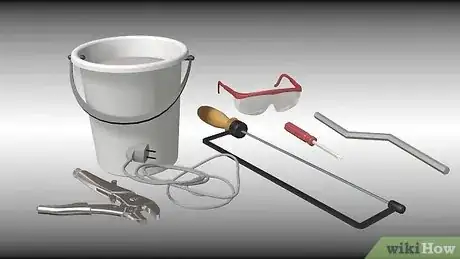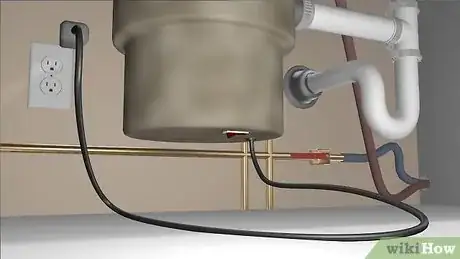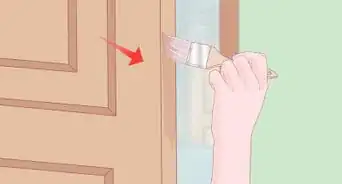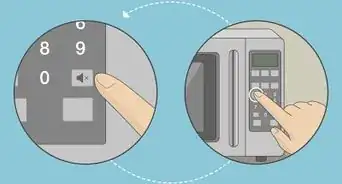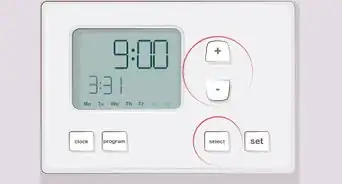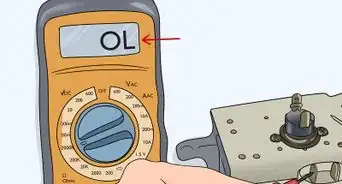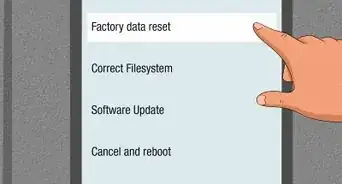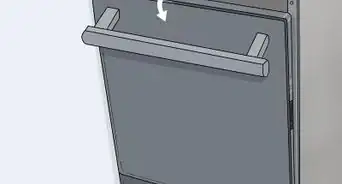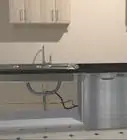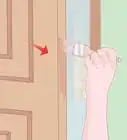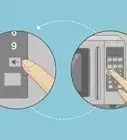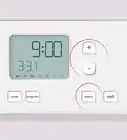This article was co-authored by James Hornof. James Hornof is a Master Electrician and the Owner and President of B & W Electric based in Denver, Colorado. With over two decades of experience in the electrical construction industry, James specializes in field installation, management, estimating, and design. He graduated top of his class in electrical trade school and studied Business Management at The Community College of Denver. James holds a Master Electrician license in Colorado, Wyoming, and Texas.
This article has been viewed 252,156 times.
Did your old garbage disposal finally break down? Installing a new garbage disposal isn't difficult as long as you have the right tools and materials. Make sure you have the right type of disposal for your plumbing, then follow these instructions to have your disposal working in no time.
Steps
Getting the Equipment Ready
-
1Figure out what kind of garbage disposal you need. When you're shopping for a new disposal, there are several factors to take into consideration. Think about who will be using the disposal, whether a noisy disposal is an issue in your household, and what kind of plumbing you have at your home.
- If you have children who will be using the disposal, consider getting a batch feed disposal rather than a continuous feed disposal. Batch feed disposals, which are a bit more expensive, require the use of a stopper prior to operation, which can be safer in households with kids. Continuous feed disposals start running when you flip a switch and keep running when you switch it off. If someone drops a utensil down the drain or sticks their hand inside, this can be a dangerous situation.[1]
- Choose a motor that's right for your household. Models with lower horsepower, usually about 1/3, are suitable for small households with a small amount of food waste. Models with 1/2 horsepower are better for larger households with more food waste.[2]
- Consider the features you want the disposal to have. For a higher price, you can buy a disposal made to function more quietly, one made from stainless steel, or one that connects to your dishwasher.
- If your plumbing is connected to a septic tank, you need to buy a disposal made especially for septic tanks.
-
2Gather tools and other supplies. In addition to an appropriate garbage disposal, you'll need the following equipment to complete the installation:
- A screwdriver
- A disposer wrench
- A hacksaw
- Water pump pliers
- Plumber's putty
- Electrical cord
- Safety supplies, including goggles and a dust mask
Advertisement -
3Turn off the power. Make sure the power to the garbage disposal is turned off while you're installing it. Cover the panel box to make sure no one can turn it back on until the job is complete.[3]
- Remember to turn off the water supply to the garbage disposal.
Removing the Old Disposal
-
1Detach the dishwasher hose. Not all disposals are connected to a dishwasher, but if yours is, use a screwdriver to loosen and detach the hose attaching the disposal to your dishwasher.[4]
-
2Detach the waste line. Remove the "P" trap waste line running from the disposal by using a wrench to unscrew the slip-nut connecting the disposal to the trap. You might want to place a bucket under the trap to catch any wastewater sitting in the bottom.
-
3Take off the disposal. Remove the disposal by inserting a screwdriver into the mounting ring lug and turning counterclockwise until it comes loose.
-
4Take apart the rest of the mounting assembly. Remove the ring on the sink sleeve, the sink sleeve, the flange, the fiber gasket, and the plumber's putty. Finish preparing the sink for the new disposal by cleaning the sleeve, flange and sink opening.[5]
Installing the New Disposal
-
1Wire the disposal. Some disposals come with appliance wires attached, and others do not. If yours doesn't, remove the cover plate beneath the disposal and attach the wires according to the manufacturer's instructions. Most standard disposals have you attach white wires to white wires and black wires to black wires. When you're finished, screw the cover plate back on.
- Run the cords for your garbage disposal up to the switch you want to use to control it.
-
2Install the drain flange and mounting ring. Roll plumber's putty between your hands to form a snake about 1/2-inch thick and 10 inches (25.4 cm) long. Apply it to the underside of the drain flange under the sink. Insert the flange into the drain hole and press down evenly to attach it. Then snap on the backup ring, fiber gasket and mounting ring.
- Working from beneath the sink, use a screwdriver to screw the mounting ring tightly against the sink. It helps to alternate sides, screwing one screw and switching to the other, so that the mounting ring tightens evenly.
- Some of the plumber's putty will have squeezed out around the flange. Use a knife to trim it away.
-
3Mount the disposal. Place the disposal into the mounting ring, making sure that the disposal's outlet is facing the drain pipe connection. Tighten it until the disposal stays in place.[6]
-
4Connect the disposal to the P-trap. Measure the discharge pipe and use a hacksaw to cut it to size, then attach it to the outlet on the disposal. Be sure to read the manufacturer's instructions to make sure you connect it properly. Attach the dishwater discharge tube as well.
-
5Check the disposal. Turn the power back on, run water into the sink and turn on the disposal to make sure it works. Check underneath to be sure there aren't any leaks. Run some food through the disposal to be sure it grinds and gets disposed of properly.
Community Q&A
-
QuestionWhat if the disposal leaks through the reset button?
 Community AnswerYou have a leak somewhere inside the seals of the disposal. Disconnect the power immediately and replace it.
Community AnswerYou have a leak somewhere inside the seals of the disposal. Disconnect the power immediately and replace it. -
QuestionWhat do I do if my garbage disposal is stopped up?
 Community AnswerVery often the circular blade inside is stuck. DO NOT REACH INSIDE TO FREE IT! Simply insert a long, sturdy, wooden handle (a broom handle will suffice) into the opening. Let it rest against the inside wall, and with force pushing down, rotate clockwise until you feel it turn freely. It may be necessary to reset the disposal. If so, locate the reset switch on the bottom of the unit. If the clog persists, use any type of drain cleaner to free it.
Community AnswerVery often the circular blade inside is stuck. DO NOT REACH INSIDE TO FREE IT! Simply insert a long, sturdy, wooden handle (a broom handle will suffice) into the opening. Let it rest against the inside wall, and with force pushing down, rotate clockwise until you feel it turn freely. It may be necessary to reset the disposal. If so, locate the reset switch on the bottom of the unit. If the clog persists, use any type of drain cleaner to free it. -
QuestionWhat do I do if the sinks fill up with waste water when the dishwasher empties?
 Community AnswerFor now, leave the water in the sink and turn off the dishwasher if the sink looks like it's going to overflow. Usually this happens because of a clog somewhere, either in the dishwasher, sink, or disposal, so check for clogs to find the source of the issue.
Community AnswerFor now, leave the water in the sink and turn off the dishwasher if the sink looks like it's going to overflow. Usually this happens because of a clog somewhere, either in the dishwasher, sink, or disposal, so check for clogs to find the source of the issue.
Warnings
- If you're attaching a dishwasher drain, be sure to knock out the seal before attaching the hose.⧼thumbs_response⧽
Things You'll Need
- A partner
- A small scissor jack
- A short length of 2X4 wood
References
- ↑ https://www.consumerreports.org/cro/garbage-disposers/buying-guide/index.htm
- ↑ https://www.consumerreports.org/cro/garbage-disposers/buying-guide/index.htm
- ↑ https://www.thisoldhouse.com/how-to/how-to-install-garbage-disposal
- ↑ https://www.digitaltrends.com/home/how-to-install-a-garbage-disposal/2/
- ↑ https://www.digitaltrends.com/home/how-to-install-a-garbage-disposal/2/
- ↑ https://www.familyhandyman.com/plumbing/how-to-replace-a-garbage-disposal/
- http://www.lowes.com/cd_how+to+install+a+garbage+disposer_1310137081_
- http://www.popularmechanics.com/home/improvement/electrical-plumbing/1276526
About This Article
To install a new garbage disposal, start by removing the old disposal and taking apart the rest of the mounting assembly. Then, attach the wires in your new disposal according to the manufacturer’s instructions, insert the drain flange, and screw the disposal into the mounting ring. Afterwards, connect the disposal to the sink trap and the dishwasher discharge tube. Finally, run water into the sink and turn on the disposal to make sure that it works. To learn more, including how to figure out what kind of garbage disposal you need, scroll down.
